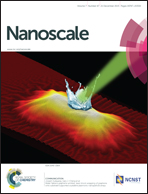Tuning plasmonic and chemical enhancement for SERS detection on graphene-based Au hybrids†
Abstract
Various graphene-based Au nanocomposites have been developed as surface-enhanced Raman scattering (SERS) substrates recently. However, efficient use of SERS has been impeded by the difficulty of tuning SERS enhancement effects induced from chemical and plasmonic enhancement by different preparation methods of graphene. Herein, we developed graphene-based Au hybrids through physical sputtering gold NPs on monolayer graphene prepared by chemical vapor deposition (CVD) as a CVD-G/Au hybrid, as well as graphene oxide–gold (GO/Au) and reduced-graphene oxide (rGO/Au) hybrids prepared using the chemical in situ crystallization growth method. Plasmonic and chemical enhancements were tuned effectively by simple methods in these as-prepared graphene-based Au systems. SERS performances of CVD-G/Au, rGO/Au and GO/Au showed a gradually monotonic increasing tendency of enhancement factors (EFs) for adsorbed Rhodamine 6G (R6G) molecules, which show clear dependence on chemical bonds between graphene and Au, indicating that the chemical enhancement can be steadily controlled by chemical groups in a graphene-based Au hybrid system. Most notably, we demonstrate that the optimized GO/Au was able to detect biomolecules of adenine, which displayed high sensitivity with a detection limit of 10−7 M as well as good reproducibility and uniformity.


 Please wait while we load your content...
Please wait while we load your content...